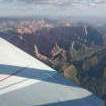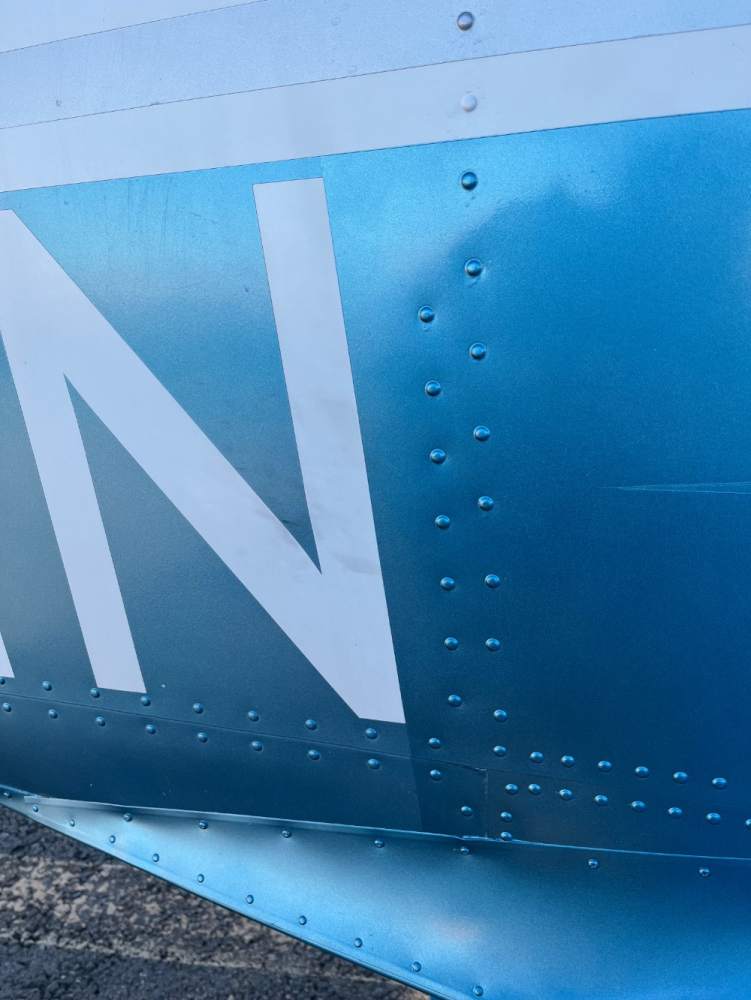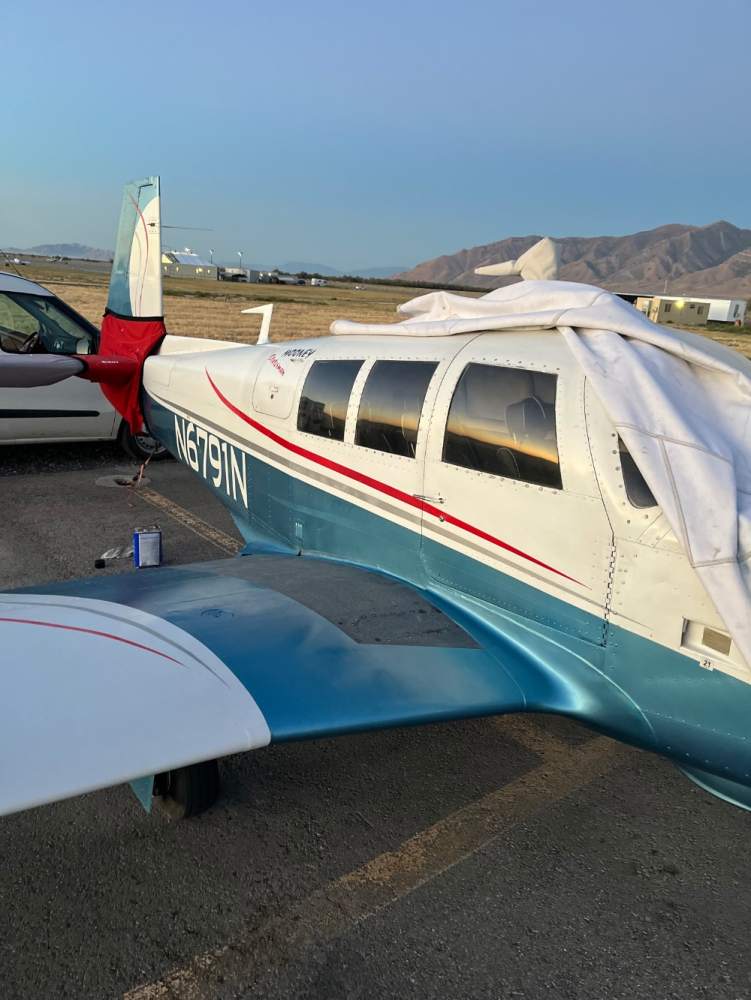-
Posts
903 -
Joined
-
Last visited
Content Type
Profiles
Forums
Blogs
Gallery
Downloads
Events
Store
Everything posted by Utah20Gflyer
-

M20G windshield replacement
Utah20Gflyer replied to MoonMech's topic in Vintage Mooneys (pre-J models)
I’d imagine if you removed the interior trim it would be fairly evident how it is installed. I’ve never done it and I haven’t looked at how the windshield is installed but based on all of the screws around the perimeter I would assume the screws go through the windshield into a backing peice and that is what is pulling it flush against the airframe. I would be very surprised if this wasn’t the arrangement. So in principle it is very easy, in practice much more difficult because of the trimming the windshield to fit properly, drilling the holes correctly and not putting any cracks in it while doing so. Very detail oriented and time consuming work with a fairly unforgiving material. -

Foggy/muted wing taxi/landing lights lenses
Utah20Gflyer replied to PeterRus's topic in General Mooney Talk
I have used premade kits to refinish plexiglass/polycarbonate and they work fine, but you can also do it with 1000 grit wet sand paper, then wet 2000 grit, then polishing compound like you’d use are a car. Don’t do swirls, straight lines. Lots of water when sanding. The good thing about a landing light lense is that it doesn’t have to be perfect like a windshield. You just want maximum light transmission and for it to look good from a couple feet away. -

Foggy/muted wing taxi/landing lights lenses
Utah20Gflyer replied to PeterRus's topic in General Mooney Talk
Have you tried polishing the old ones? Normally you can get them to almost new condition with a relatively small amount of work. Maybe an hour or two. I’d at least try before going through the time and expense of replacing them. -

Ignition (Tumbler) Rebuild Kit
Utah20Gflyer replied to Matthew P's topic in Vintage Mooneys (pre-J models)
I had this exact problem. The solution was to take out the front half of the ignition switch (it splits in two with 2 flat head screws holding it together) and take it to a locksmith and have them rebuild the lock cylinder. I paid 50 dollars and the new keys and rebuilt cylinder worked perfectly. Fortunately all the wires are attached to the back part of the ignition switch so there isn’t a lot involved in getting the part you need removed. It may be helpful to ask around your local area and find someone with aircraft experience. The guy I used said he used to rekey planes all the time. I think any competent locksmith could get it done for you but experience doesn’t hurt. -

AV-30 vs. Garmin 275 vs. Garmin G5 vs. ______
Utah20Gflyer replied to wolfbyte's topic in Avionics/Panel Discussion
Another benefit of the GI 275 HSI is you can run older non Garmin radios into it. This would allow you to get rid of the CDIs as well if you wanted to. The G5 is much more limited in that area. I did my upgrades in stages and initially I had a KX 175B ran into it and it worked fine. Later I switched to a Garmin 255. I’d consider getting a new pilots side panel cut out since the current one will have to come out completely for the upgrade anyway. It’s a relatively affordable time to do it and it will modernize the look significantly. -

AV-30 vs. Garmin 275 vs. Garmin G5 vs. ______
Utah20Gflyer replied to wolfbyte's topic in Avionics/Panel Discussion
Yeah, my instrument scan is just going back and forth between the two GI275s. The HSI is awesome. Makes holds, procedure turns , DME arcs , etc easy. I couldn’t imagine going back to a heading indicator now. Overall very happy with the upgrade. -

AV-30 vs. Garmin 275 vs. Garmin G5 vs. ______
Utah20Gflyer replied to wolfbyte's topic in Avionics/Panel Discussion
I think the Uavionix products are acceptable with the addition of a magnetometer which I think is still in the approval process for certified planes. So maybe not quite ready for prime time but getting close. I did two GI275s and they are great. I like that two of them replaces the entire 6 pack. The AV30 and G5 you only get to replace 2 instruments and have to keep the other 4 legacy instruments. I like the idea of getting rid of things that have to be maintained. I did keep my airspeed indicator but got rid of the others and created room for a panel mounted I phone max that I display foreflight on. -

Looking for a Mooney M20C, M20E, M20F
Utah20Gflyer replied to TurboK's topic in Vintage Mooneys (pre-J models)
Based on the price range a low time prop/engine is going to be a low usage engine with an old overhaul which likely negates the benefit you are looking for. I would instead look for a higher time and high usage engine which is actually more likely to run a while without needing a major repair. You are likely going to have to accept old radios and no gps and less desirable paint and interior. The most important thing to look for is high usage and regular maintenance. In the long run you’ll probably be better off spending more on the purchase and get a very nicely kept specimen. In three years I’ve spent more on maintenance and upgrades than I did on the initial purchase. -
The airframe is the same as an F model of the same vintage and the engine should be a wide deck Lycoming O360 A1D which is a very common Mooney engine. No special concerns getting parts.
-
If I had to choose between reducing throttle or reducing prop rpm I would reduce prop rpm because at least theoretically you would get better performance per gallon of fuel burnt. It’s two different ways of accomplishing the same thing. The only reason I wouldn’t is if there was a problem with running smoothly or vibration issues at lower rpm. I normally cruise between 2300 and 2400. I very rarely will use 2500.
-
In the west a turbo is very useful. 4k foot runway in the summer is kind of short but doable if you set good rules and stick to them. I fly off a 6k runway and that is xtra 2k is nice when it’s hot. Your budget is a bit light for a K but you might be able to get one in decent condition with older radios. My next plane will very likely be a turbo’d plane. So I’d go with a K if you can swing it.
-

Mooney Mustang for sale in ATL
Utah20Gflyer replied to Red Leader's topic in Modern Mooney Discussion
I think some of the qualifications of a M22 owner would be first an evangelical desire to keep a rare Mooney flying. If you want a pressurized plane to travel the country buy a Malibu or P210. Second a lot of experience in aircraft maintenance and sourcing parts. This is not a plane you can drop off at your neighborhood mechanic and pick it up the next week. Last, a very high ability to navigate regulations and a talent for justifying minor changes as well as major alterations via 337s. -

Turbine Bonanza setting the pace?
Utah20Gflyer replied to Rick Junkin's topic in General Mooney Talk
Short hop cargo ops makes sense for non pressurized turbo props. Power to weight is excellent and the high fuel burn doesn’t matter if you are only flying an hour away. That leaves a lot of weight capacity for cargo. -

Turbine Bonanza setting the pace?
Utah20Gflyer replied to Rick Junkin's topic in General Mooney Talk
A non pressurized turbo prop seems very impractical to me. -

Video of door pop, pilot error (not Mooney)
Utah20Gflyer replied to 201er's topic in Mooney Safety & Accident Discussion
I had the door pop open once when I let my wife close the door. It popped open 5 minutes into a 35 minute flight on a warm day. I just completed the flight. In a Mooney if it’s not really cold it’s just an annoyance. -
This something you’d have to discuss with your IA. The STC wouldn’t apply to your plane but it may be possible to do it with a 337 since your planes battery set up is now like the aircraft the STC does apply to.
-
Too bad it didn’t include vintage Mid bodies, I wonder how different our Fs and Gs are?
-
The route through the central Rockies is following I-80. Through southern Wyoming, dropping down into Utah via a pass and then across the Great Basin. You would cross the Sierras around Lake Tahoe. You could do that route in good VFR conditions as low as 9k MSL. It’s a pretty direct route.
-
This is a strange question. If we are to assume everything works properly on the plane then it should start readily using the procedure in the POH. If it doesn’t then I personally would assume there was something wrong with the plane. It doesn’t sound like this is an assumption you want to make. I would suggest finding another mechanic to help troubleshoot the issue in person. I’m not saying there is anything wrong with the current mechanic, I’m suggesting a different person will have their own unique way of approaching the problem and may find the answer.
-
I’d agree with the guy that sold you your plane. Just because you can doesn’t mean you should. One of the things you learn flying a Johnson bar Mooney is you want to get your gear up early because the faster you are going the harder it gets. You don’t get that feedback from an electric gear system but the parts are getting the extra wear and tear anyway. I try to not drop gear or put in flaps until I hit 100 mph or roughly 90 knots. This is in a mid body Mooney so that speed may not apply to a long body. Ultimately it’s your plane and it’s up to you how you want to fly it.
-

J small and large paint touch ups
Utah20Gflyer replied to Thedude's topic in Modern Mooney Discussion
Here a little better picture of the results. The second picture shows the one spot where the transition is noticeable. With some forethought you can hide the transitions a lot of the time. All in all I think it’s a big improvement. FYI I took the picture in a way that made the transition as noticeable as possible. Few people would see it at 10 feet. -
I have a pair of GI 275 s, the HSI is awesome and well worth the money to me, but if you want to maintain CB status then the overhaul is the obvious choice. You could be as happy as you ever were for the low price of 600 bucks, GI275 is going to be 10x that easily.
-

J small and large paint touch ups
Utah20Gflyer replied to Thedude's topic in Modern Mooney Discussion
As others have said you don’t want to sand bare aluminum because of the Alclad layer. The technique I use for this situation is I prep the bare aluminum with alodine and then spray the area with primer. The transition will be very noticeable but at this stage that’s ok. Take a small piece of 400 grit sand paper and use your finger tip to sand just that transition line. The goal is to remove the line without going through the primer. If you begin to go through, apply more primer and then continue. Once the line is gone spray again with primer and sand again. Use Wet/dry sandpaper and use plenty of water. Then you should be ready to spray your color coat. This probably sounds time consuming because it is, but it’s also very cheap if you don’t value your time. You’ll probably never get a 10/10 paint job but I think you can get it to an 8 with some effort. here is a before and after from last weekends work, keep in mind I need to wet sand and buff the clear coat to even out the sheen, currently it looks a little splotchy. I also need to respray the silver stripe. While I’m doing the one in the blue I’ll also respray the one above in the White. This project probably took 8 hours of labor so far and is not complete. All but an hour was monotonous sanding, cleaning and taping. -
As others have said, I’d just send it to aeromotors. Although someone could possibly change some seals for cheaper I doubt it’s going to be significantly cheaper than just having it overhauled. Aeromotors will also update some things that will make the pump better than new.
-
Sounds like your flap system might need some attention and as an owner of a hydraulic flap Mooney I don’t have much to add on troubleshooting an electric flap Mooney. I would however question why you would put out flaps at 100 kts or even higher. Seems like that’s a bit fast. 90kts is a nice pattern speed for a mid body Mooney, and also works well as an approach speed. Putting out flaps and gear at higher speeds creates a lot of extra wear and tear on the systems. Ultimately it’s your plane so it’s your choice and I’m not saying people are wrong if they choose to operate their airplane differently than I operate mine. There are however benefits to slowing down in the pattern and one of them is less wear and tear on the airframe.







